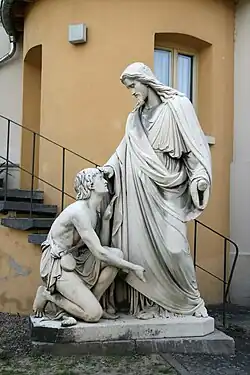Healing the blind near Jericho
Each of the three Synoptic Gospels tells of Jesus healing the blind near Jericho, as he passed through that town, shortly before his passion.

The Gospel of Mark tells of the curing of a man named Bartimaeus, healed by Jesus as he is leaving Jericho. The Gospel of Matthew and the Gospel of Luke include different versions of this story.
Narrative
The Gospel of Mark (10:46–52) tells of the curing of a blind beggar named Bartimaeus (literally "Son of Timaeus"). He is one of the few recipients of healing whose names evangelists let us know. As Jesus is leaving Jericho with his followers, Bartimaeus calls out: 'Son of David, have mercy on me!' and persists even though the crowd tries to silence him. Jesus has them bring the man to him and asks him what he wants; he asks to be able to see. Jesus tells him that his faith has cured him; he immediately receives his sight and follows Jesus.
Apart from telling a miracle story that shows the power of Jesus, the author of the Gospel uses this story to advance a clearly theological purpose. It shows a character who understands who Jesus is and the proper way to respond to him – with faith. The beggar, on being called to Jesus, discards his cloak, symbolizing the leaving behind of possessions. And the use of the title 'Son of David' – the only occasion on which this is used in the Gospel of Mark – serves to identify Jesus as the Messiah.[1] It was also a reference to Jesus' kingly authority, which the Jews would have seen as placing him at odds with Caesar. The emperor was the perceived proper referent of the call of kyrie eleison, as he would have been referred to as kyrios in Greek ('lord' in English).[2]
The Gospel of Matthew has two unnamed blind men, sitting by the roadside; Jesus is 'moved by compassion' and touches their eyes. 20:29–34 A version of the same story is told earlier in the narrative, when Jesus is preaching in Galilee. On this occasion, he asks the blind men if they believe he can cure them, and when they assure him that they do, he commends their faith and touches their eyes, restoring their sight. He warns them to tell nobody of this, but they go and spread the news throughout the district. (Matthew 9:27-31)
The Gospel of Luke 18:35–43 handles the story in a different way; there is one unnamed blind man, and the author shifts the incident to take place as Jesus is approaching Jericho, so it can lead into the story of Zacchaeus.[3]
Son of David
Vernon K. Robbins emphasizes that the healing of Bartimaeus is the last of Jesus’ healings in Mark, and links Jesus' earlier teaching about the suffering and death of the Son of Man with his Son of David activity in Jerusalem.[4][5] The story blends the Markan emphasis on the disciples' 'blindness' – their inability to understand the nature of Jesus' messiahship – with the necessity of following Jesus into Jerusalem, where his suffering and death make him recognizable to Gentiles as Son of God (see Mark 15:39 where, at the crucifixion, the Roman centurion says "surely this man was son of God").[6]
Paula Fredriksen, who believes that titles such as "Son of David" were applied to Jesus only after the crucifixion and resurrection, argued that Mark and Matthew placed that healing with the proclamation "Son of David!" just before "Jesus' departure for Jerusalem, the long-foreshadowed site of his sufferings."[7] The title "Son of David" is a messianic name.[8][9] Thus, Bartimaeus' exclamation was, according to Mark, the first public acknowledgement of the Christ, after St. Peter's private confession at Mark 8:27–30.
Bartimaeus
The naming of Bartimaeus is unusual in several respects: (a) the fact that a name is given at all, (b) the strange Semitic-Greek hybrid, with (c) an explicit translation "Son of Timaeus." Some scholars see this as confirmation of a reference to a historical person;[10] however, other scholars see a special significance of the story in the figurative reference to Plato's Timaeus who delivers Plato's most important cosmological and theological treatise, involving sight as the foundation of knowledge.[11]
Notes
- Stephen Ahearne-Kroll, The Psalms of Lament in Mark's Passion: Jesus' Davidic Suffering (Cambridge University Press, 2007) pages 138-140
- "Kyrie Eleison". Encyclopedia.com.
- Luke Timothy Johnson, The Gospel of Luke (Liturgical Press, 1991) page 283.
- Jesus the Teacher: A Socio-Rhetorical Interpretation of Mark by Vernon K. Robbins 2009, ISBN 978-0-8006-2595-5. 41-43.
- Vernon K. Robbins, “The Healing of the Blind Bartimaeus (10:46-52) in the Marcan Theology” Archived 2015-09-24 at the Wayback Machine, Journal of Biblical Literature 92 (1973), 224-243
- Vernon K. Robbins, "The Reversed Contextualization of Psalm 22 in the Markan Crucifixion: A Socio-Rhetorical Analysis" Archived 2018-12-21 at the Wayback Machine (1992)
- Fredriksen, From Jesus to Christ, p. 181.
- "Reflections: The blind Bartimaeus: Mark 10:46-52," October 24, 2009, The Manila Bulletin, The Manila Bulletin website Archived 2009-10-26 at the Wayback Machine, citing365 Days with the Lord, (St. Paul's, Makati City, Philippines) from St. Paul's website , accessed October 28, 2009.
- Barrie Wetherill, "Jesus cures blind Bartimaeus," from The Life of Jesus Christ, found at EasyEnglish Bible study. Accessed October 28, 2009.
- Vincent Taylor. The Gospel according to St. Mark. 1966 St. Martin's Press Inc. p 448.
- Mary Ann Tolbert, Sowing the Gospel: Mark's World in Literary-Historical Perspective 1996, Fortress Press. p189.
See also
References
- Paula Fredriksen, From Jesus to Christ (2000), ISBN 0-300-08457-9
- Vernon K. Robbins, Jesus the Teacher: A Socio-Rhetorical Interpretation of Mark 2009, ISBN 978-0-8006-2595-5
